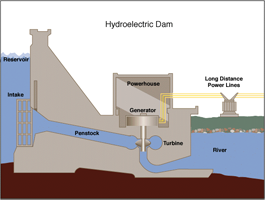Energy From Moving Water

Source: National Energy Education Development Project (Public Domain)

Source: Tennessee Valley Authority (Public Domain)
Hydropower Generates Electricity
Hydropower is the renewable energy source that produces the most electricity in the United States. It accounted for 6% of total U.S. electricity generation and 63% of generation from renewables in 2011.
Hydropower Relies on the Water Cycle
Understanding the water cycle is important to understanding hydropower. In the water cycle:
- Solar energy heats water on the surface, causing it to evaporate.
- This water vapor condenses into clouds and falls back onto the surface as precipitation (rain, snow, etc.).
- The water flows through rivers back into the oceans, where it can evaporate and begin the cycle over again.
Mechanical Energy Is Harnessed from Moving Water
The amount of available energy in moving water is determined by its flow or fall. Swiftly flowing water in a big river, like the Columbia River that forms the border between Oregon and Washington, carries a great deal of energy in its flow. Water descending rapidly from a very high point, like Niagara Falls in New York, also has lots of energy in its flow.
In either instance, the water flows through a pipe, or penstock, then pushes against and turns blades in a turbine to spin a generator to produce electricity. In a run-of-the-river system, the force of the current applies the needed pressure, while in a storage system, water is accumulated in reservoirs created by dams, then released as needed to generate electricity.
History of Hydropower
Hydropower is one of the oldest sources of energy. It was used thousands of years ago to turn a paddle wheel for purposes such as grinding grain. Our Nation's first industrial use of hydropower to generate electricity occurred in 1880, when 16 brush-arc lamps were powered using a water turbine at the Wolverine Chair Factory in Grand Rapids, Michigan.
The first U.S. hydroelectric power plant opened on the Fox River near Appleton, Wisconsin, on September 30, 1882.
Because the source of hydroelectric power is water, hydroelectric power plants must be located on a water source. Therefore, it wasn't until the technology to transmit electricity over long distances was developed that hydropower became widely used.



